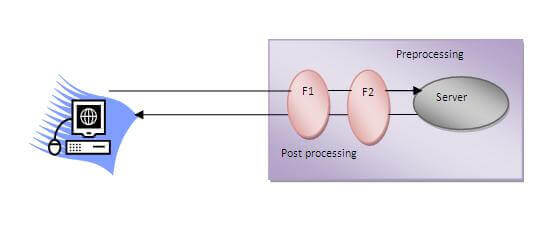Servlet FilterA filter is an object that is invoked at the preprocessing and postprocessing of a request. It is mainly used to perform filtering tasks such as conversion, logging, compression, encryption and decryption, input validation etc. The servlet filter is pluggable, i.e. its entry is defined in the web.xml file, if we remove the entry of filter from the web.xml file, filter will be removed automatically and we don't need to change the servlet. So maintenance cost will be less. 
Note: Unlike Servlet, One filter doesn't have dependency on another filter.Usage of Filter
Advantage of Filter
Filter APILike servlet filter have its own API. The javax.servlet package contains the three interfaces of Filter API.
1) Filter interfaceFor creating any filter, you must implement the Filter interface. Filter interface provides the life cycle methods for a filter.
2) FilterChain interfaceThe object of FilterChain is responsible to invoke the next filter or resource in the chain.This object is passed in the doFilter method of Filter interface.The FilterChain interface contains only one method:
How to define FilterWe can define filter same as servlet. Let's see the elements of filter and filter-mapping. For mapping filter we can use, either url-pattern or servlet-name. The url-pattern elements has an advantage over servlet-name element i.e. it can be applied on servlet, JSP or HTML. Simple Example of FilterIn this example, we are simply displaying information that filter is invoked automatically after the post processing of the request. index.htmlMyFilter.javaHelloServlet.java
download this example (developed using Myeclipse IDE)
download this example (developed using Eclipse IDE) download this example (developed using Netbeans IDE)
Next TopicAuthentication Filter
|
 For Videos Join Our Youtube Channel: Join Now
For Videos Join Our Youtube Channel: Join Now
Feedback
- Send your Feedback to [email protected]
Help Others, Please Share










